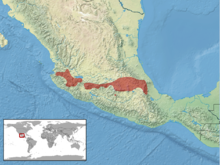Mexican plateau rattlesnake
| Mexican plateau rattlesnake | ||||||||||||
|---|---|---|---|---|---|---|---|---|---|---|---|---|
| Systematics | ||||||||||||
|
||||||||||||
| Scientific name | ||||||||||||
| Crotalus triseriatus | ||||||||||||
| Wagler , 1830 |
The Mexican plateau rattlesnake ( Crotalus triseriatus ) is a species of rattlesnakes ( Crotalus ) from the mountainous regions of the central Mexican plateau. The highest finds of this species are at an altitude of 4,572 meters, which makes this species the snake that occurs in the highest habitats recorded to date.
features
The edged head rattlesnake is a relatively small rattlesnake with an average body length of about 50 centimeters, which in rare cases can also be 60 centimeters long. On the sides of the head, two light lines, mostly white, with a light brown space parallel to the cleft of the mouth run along.
The typical basic color is rusty brown or gray, the pattern consists of large rectangular and dark spots, which are bordered by a black or dark brown line from and behind. The spaces between the spots are lighter to white, so that a secondary drawing of light transverse bars is created. The subspecies C. t. armstrongi shows a sexual dimorphism , with the females brown to gray and the males greenish to yellow.
distribution and habitat
The range of the snake stretches along the southern edge of the central Mexican plateau in the volcanic highlands along the states of Jalisco , México , Michoacán , Morelos , Nayarit , Puebla , Tlaxcala and Veracruz .
The snake's habitat is dominated by loose pine and oak forests. It prefers grassy clearings near bodies of water. The highest finds of this species are at an altitude of 4,572 meters, which makes this species the snake that occurs in the highest habitats recorded to date.
Snake venom
No information is available on the specific effects of the poison of this type.
Systematics
There are currently two subspecies of the forest rattlesnake:
- C. t. armstrongi in the eastern part of the distribution area
- C. t. triseriatus in the western part of the distribution area.
literature
- Chris Mattison: Rattlers! - A natural history of rattlesnakes. Blandford, London 1996; Pp. 126-127; ISBN 0-7137-2534-6
Web links
- Crotalus triseriatus in The Reptile Database
- Crotalus triseriatus inthe IUCN 2013 Red List of Threatened Species . Posted by: Canseco-Márquez, L. & Mendoza-Quijano, F, 2007. Retrieved October 5, 2013.
